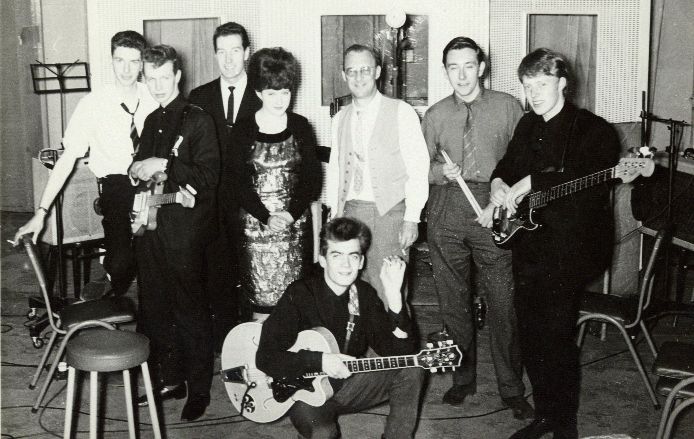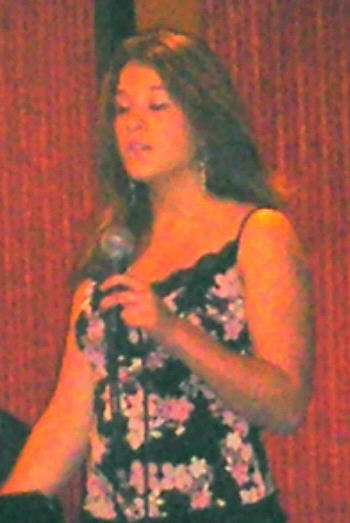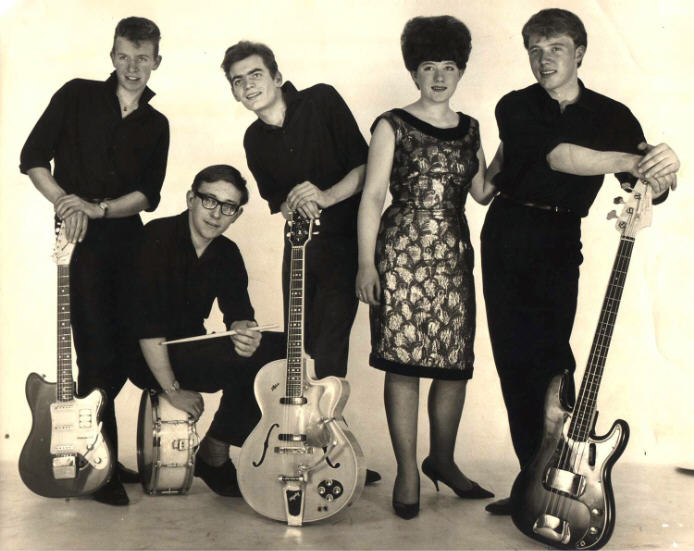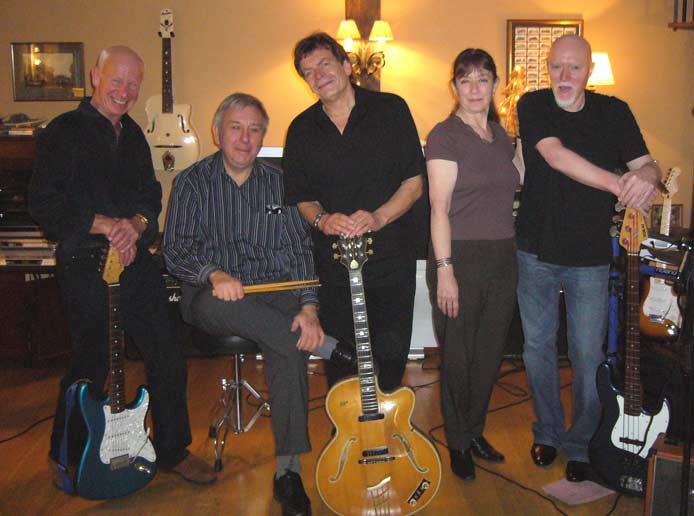


Jill & The Boulevards pose with Bob Barrett, Norman (Hurricane) Smith, and Norrie Paramour in Studio ", Abbey Road, London.
Jill & the Boulevards
(J&TB) originated as a London based band, formed in 1961, as a
result of
John Turner visiting Joe Meek’s legendary studio in Highgate,
with his sister
Jill on vocals and a guitarist friend, to record his latest
composition,
“Eugene”. (Note:
John Turner still
has a copy of this demo!)
John & Jill Turner lived in Hampstead, just down the road from the Abbey Road recording studios, where John sent the demo to Norrie Paramor at Columbia records. In response, Norrie asked John to put a band together for a recording test, which proved successful. By that time, John had written “And Now I Cry”, so both songs were recorded at the session and, subsequently, the new song was chosen as the ‘A’ side of the single.
It’s interesting to note here that Brian Epstein had also sent a demo tape of a Liverpool band, named The Beatles, to Columbia and they had been invited for a recording test around the same time. However, as luck would have it, Jill & the Boulevards were signed up to Columbia and The Beatles were turned down. The Beatles had to wait a few more months before they landed a contract with Parlophone records, with George Martin acting as their A&R manager.
Jill & the Boulevards comprised Jill Turner on vocals, John Turner (Fender Precision bass), Mike Hickling (lead guitar, Futurama III), Michael Lloyd (rhythm guitar, Hofner President) and Reg Montague on drums.
The band returned to Studio 2 at EMI Abbey Road in February 1962, to rerecord "And Now I Cry" and “Eugene", for the final takes. The above photo was taken at the end of the session, featuring the band, Norrie Paramor and Bob Barrett (A&R) and Norman (Hurricane) Smith (Recording Engineer). Norman Smith went on to engineer many of the Beatles and Pink Floyd recordings and also had a successful run of hit singles in the 1970s. Norrie was of course the man responsible for many EMI records, particularly those of Cliff Richard, The Shadows & Helen Shapiro.
“And Now I Cry” &
“Eugene” was released on Columbia in April 1962,
and became Radio Luxembourg’s
“Record of the Week”. The record was reviewed in
all the music papers, which
featured a variety of publicity photos taken
by legendary photographer Dezo Hoffman, one of which is reproduced
below.
Had the record been a
success, it is likely that Jill & the Boulevards would have
been featured
on the Beatles British tour the following year, and could well have
been part
of the “British Invasion” of the USA. However, they
did successfully audition
for a spot on Adam Faith’s 1962 UK tour but,
unfortunately, Adam then made the unusual
decision to try his hand at cabaret so the tour
never actually went ahead. Therefore, sadly, none of the Jill &
the Boulevard’s songs has ever been performed in public, i.e.
until 2005 (see
below).
Another link with The Beatles
was when Michael Lloyd met up with George Harrison and visited him
regularly at
his bungalow in Esher, Surrey.
Michael recalls
that George was a very generous person and their mutual interest was
“12-
string” guitars and “1950s
Rock‘n’Roll”. So much so that George lent
Michael
both his 12-string Rickenbacker guitars, at different times, during the
period
1966 to 1967. One he collected from George at the Abbey Road studios,
during
the recording of “Doctor Robert” for the
“Revolver” album. The other he
collected from Denny Laine, who had previously borrowed it for a
recording
session with The Moody Blues. George also gave Michael a couple of
lessons on
his sitar. On another occasion, one winter’s afternoon in
early 1967, they
recorded some “tape loops” together, in
George’s small studio, with George
playing his red Gibson SG and Michael on George’s Vox
Continental keyboard.
These produced guitar & fairground organ type sound effects
similar to
those heard subsequently on “Being for the Benefit of Mr. Kite” on the “Sergeant
Pepper“ album. Who knows, they may even have ended up
on the actual record, a few months later!
Another memory of
that
session was playing the small “zither” type
instrument that is predominant on
“Strawberry Fields Forever”.
Strangely enough Michael & George never
discussed their mutual
experiences with Columbia records, since this connection only came to
light
many years later in Mark
Lewishon’s book, detailing
the Beatles recording sessions. Unfortunately, Michael
lost contact with
George when he moved to Henley.
The Boulevards
struggled
on, Jill departed and later in 1962 they returned to Joe Meek's studio
in
Highgate, with singer Pete Lacey, to record two more of
John’s songs, hoping
that either Joe Meek or Columbia would release these as the
Boulevards’ second
single. The tracks recorded at that session were “Lover
Return” and “You’re My Girl”.
However, nothing came of it
and the band broke up shortly after. Fortunately they had obtained a
couple of pressings
of the Joe Meek demo tracks, such that 43 years later, in October 2005,
the
best copy was digitally remastered and released for the first time (see
below).
If
anyone gets the chance to hear any of these
four tracks, they will be impressed by the overall sound of the band
and Jill’s
amazing voice. Mike Hickling’s excellent guitar solos
featured a red Futurama
III, into a 10 watt Watkins (WEM) Westminster. Michael’s
“clanky” Hofner
President is also unmistakeable, on rhythm guitar. These were basically
budget
instruments so they were rarely heard on professional recordings.
Norman Smith (recording
engineer at EMI) was “knocked out” by the sound
from the little Watkins Westminster
amplifier. That says a lot for the amp, especially considering he was
used to
working with classic equipment, including the Shadows’ Vox
AC15s & AC30s.
Incidentally, the bass and
rhythm guitarists had to share John’s Fender Bassman
amplifier since there was,
surprisingly, no house amplifier available either in Abbey Road Studio
2, or
Joe Meek’s studio, at that time.
Steve then added a series of web-pages
featuring Hofner users,
including Jill & the Boulevards. This has resulted in Michael
Lloyd being
contacted by people from all over the world, who had bought/and lost
the
record, or heard it on the radio. Many consider “And Now I
Cry” to be one of
their favourite singles of all-time. These “fans”
were particularly pleased to
discover the website since, up till then, Jill & the Boulevards
had been
one of the “mystery” bands of the 1960s.
It was then discovered that “And Now I Cry” had been digitally re-mastered and released on a CD compilation of British girl singers from the 1960s, including Elkie Brooks, Cilla Black and Helen Shapiro. This was released as “Dream Babes, Vol 2: Reflections" and is still available on RMP Records UK, part of Sanctuary Records.
This is where the J&TB story takes a “new twist”. In 2004 a young lady named Hannah Lindsey walked into “Tower Records” in Denver, looking for a CD featuring British girl singers, to find a song to perform at the “British Invasion Pops Show” at Denver School of the Arts, where she was a student.
She discovered “Dream Babes Vol 2” and out of the 22 songs, decided that “And Now I Cry” was the song for her. This was largely down to its unusual sound, together with the fact that Jill’s fantastic vocal range fitted Hannah’s voice perfectly. The only problem was that Hannah was unable to obtain the music for this complex song (comprising many minor chords) so she and her mother resorted to the internet, where they discovered Steve’s Vintage Hofner website and Michael’s contact details. Fortunately Michael still retained the chord sheets from the original Abbey Road session, so was pleased to oblige and score the song for Hannah to perform, in March 2005.
This was particularly significant, as this was
the first ever live
performance of a J&TB song and Hannah did a brilliant job on
it, judging
from the DVD recording of the show. As a result of this, Michael
visited the
Denver School of Arts in January 2006, to meet Hannah and present a
master
class to 350 students on “The British Invasion”. He
also performed “And Now I
Cry”, live with Hannah, which was quite an experience in
itself, considering it
was the first time he had played it since the Abbey Road session in
1962.

Hannah Lindsey performing in Denver, USA.
Another major development in 2005 was the
release of the two Pete &
the Boulevards demo tracks (recorded at Joe Meek's studio in Highgate
in 1962)
on “Joe Meek:
The RGM Legacy - Portrait of a Genius
[box set]”
The songs featured were “Lover
Return” and “You’re My Girl”
and the
compilation is still available on Castle Records, part of Sanctuary
Records.
This was followed a year later by the release of “Telstar-The Hits of Joe Meek” [double CD], featuring the same two songs.
In 2007, Norman “Hurricane”
Smith’s biographer was searching the web
and came across Steve Russell’s Hofner website, where he
discovered the
connection between Norman and Jill
&
the Boulevards, with the result that
the
band are now to be featured in Norman’s biography, which is
to be entitled
“John Lennon Called Me Normal” and is scheduled for
publication in April 2008.
The scene was set for a reunion of Jill
& the Boulevards. The only
problem had been that despite a 10 year search, Michael Lloyd had been
unable
to trace Jill & John Turner. However, thanks once again to the
Hofner
website, their young sister had found the webpage via
“Google” and they eventually
made contact. The reunion of the whole band took place in December
2007, nearly
46 years after they were last all together in Studio 2, at Abbey Road.
The band are already planning to return to the
studio to re-record
their Columbia tracks and also to record some more of John’s
songs, which were
originally composed in the early 1960s for their first LP, which never
materialised, and they are hoping to do a few live gigs - so watch this
space!!!
If anyone has a story to tell about the band’s recordings or would like more information on Jill & the Boulevards or Pete & the Boulevards, please contact Michael Lloyd at mfl_uk@yahoo.co.uk

Original publicity photo taken by legendary photographer Dezo Hoffman in February 1962.

Recent photo taken at the reunion of Jill & the Boulevards - December 2007.
Return to EARLY UK BANDS PAGE
Return to the VINTAGE HOFNER INDEX PAGE